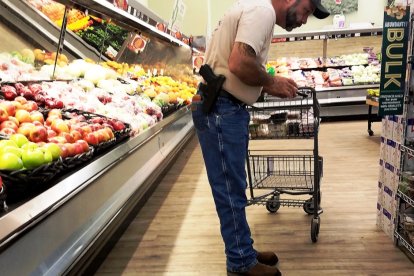1.7 million defensive uses of firearms are made each year
The data is based on the largest study ever conducted on gun ownership and use, conducted by Georgetown University.

Concealed Carry / Gilbert Mercier (Flickr).
The 2021 National Gun Report, written by William English of Georgetown University, has been published. Based on the survey of gun use of 16,708 Americans, the report concludes that there are more than 81 million gun users in the country, nearly 31% of the U.S. population.
However, the most relevant conclusion of the report is not that, but that almost a third of gun owners, 31.1%, have used them to defend themselves or their property. This means that 1.67 million defensive uses are made each year.
Weapons against crime
This result takes on special value at this time, when there is an increase in crime in the United States. In addition, the right to bear arms, which is part of the Constitution under the Second Amendment, is under suspicion by the increase of mass shootings in the streets.
A majority of citizens who own guns, 56.2%, have them for protection. One in three, 35%, carry guns with them with some frequency. According to the report:

Mark and Patricia McCloskey / Cordon Press.
25.3 million people have defended themselves with them
According to the study, around 25.3 million citizens have defended themselves or someone else at some time because they owned a gun. Combined, they will have made more than 50 million defensive uses of the weapons. The study does not require that the weapon be fired, only that it be shown or mentioned to appease someone's aggressive behavior. In fact, 81.9% of defensive uses consisted of simply showing the weapon. In half of the cases in which shots were fired, one shot was enough.
William English shows that it is the generally non-violent uses of weapons for defense that have made it so complicated to measure. An important report conducted almost three decades ago on the same question by criminologists Gary Kleck and Mark Gertz obtained similar results: 2.5 million defensive uses per year.
Defensive and safe use
The author spoke to the trade publication The Reload, and discussed the reasons why most defensive uses do no harm and yet are effective:
Still, the author himself acknowledges that his estimate of the defensive number of guns may be too conservative, and underestimates the effect of gun freedom on crime control. English has only asked citizens who own guns. This is logical in principle, but it is not necessary to have it on you to simulate that you are going to draw a weapon or that you may have one.
The debate
What is at issue in the debate is not guns, but their regulation. Supporters of gun control say that the freedom to own and use guns encourages criminals to have access to them, therefore increasing crime.
Gun freedom advocates say that criminals who need guns will always be able to access them, even if they are banned. However, it will be law-abiding citizens who will be left unable to use them. Since they will use them, among other reasons, to defend themselves, banning their possession and use will lower the number of times law-abiding citizens defend themselves against criminals.
The relevance of the report
The importance of this report is that it surpasses all previous reports in terms of the extent and depth of the data it provides, and the study included aspects that other reports had left out:
The study is based on interviews with 44,000 citizens in all 50 states, of which 16,708 gun owners were questioned for further information. This study is part of a book William English is writing on guns and their use in the United States.
Americans own 415 million guns, of which 171 million are handguns, 146 million are rifles, and 98 million are shotguns. The report also provides updated data on the number and type of weapons owned by citizens. For example, the average holder has five weapons. Almost half, 48.0%, have magazines for 10 or more rounds. 30.2% (44 million citizens) own AR-15 style rifles.
RECOMMENDATION





















